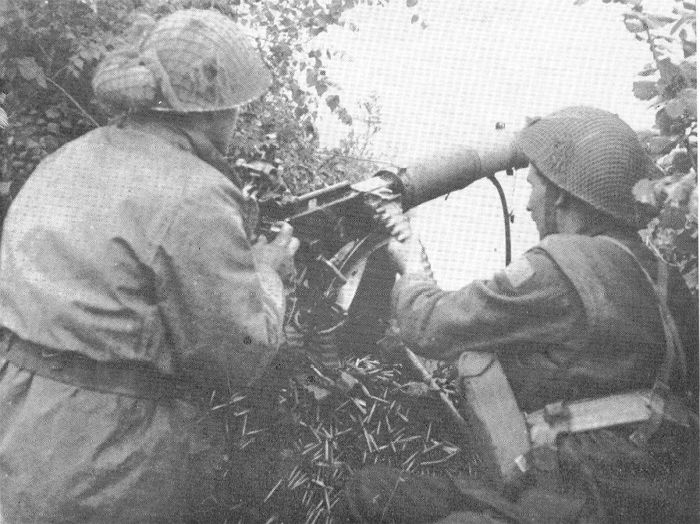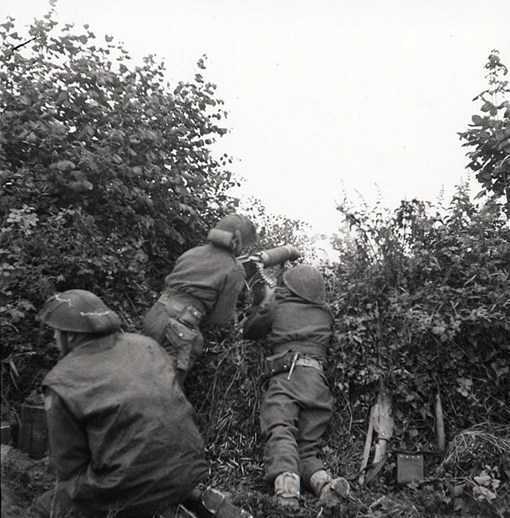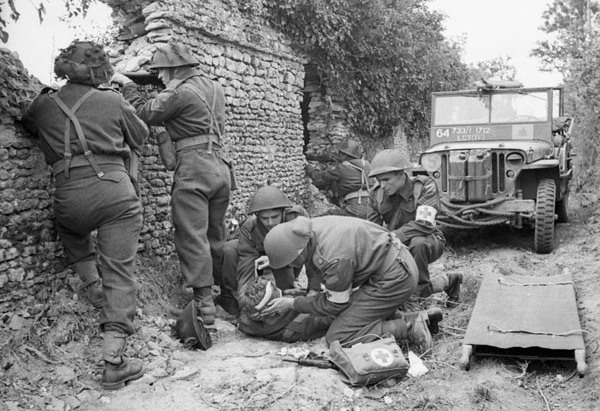

The Cameron Highlanders of Ottawa (M.G.) was a Machine Gun Battalion. On D-Day the Camerons were placed directly under the command of the Brigades of the 3rd Canadian Infantry Division . The Battalion was organized into 'A', 'B' and 'C' Companies as Machine Gun companies, and 'D' Company as a Heavy Mortar Company. Each Machine Gun Platoon supported an Infantry Battalion with the exception of No. 7 Platoon, which was under the direct command of the North Shores whose job was to take out the Radar Station. The Camerons were equiped with the Vickers .303 machine gun, a medium weapon fed by 250 round cloth belts of .303 ammunition and fired in full automatic bursts of 10 to 20 rounds.
Advance recce parties landed with the assaulting infantry and the Machine Gun Platoons followed as soon as the beaches were clear to allow vehicles to come ashore. The three Machine Gun Companies landed without fatal casualties and took up position with their Brigades. 'A' Company, with their Vickers .303 machine guns, supported the 7th Brigade onto its intermediate objective along the line Fontaine-Henry-le-Fresne-Camilly where they firmed up for the night.
'B' Company landed with the 8th Brigade. No. 7 Platoon under Lt. Sharp took up position near the railway station at St. Aubin-Sur-Mer and shot the North Shores into Tailleville. No. 6 Platoon under Lt. Woodward landed at St. Aubin and cleared the lateral road to Bernieres-Sur-Mer to join up with the Queen’s Own Rifles. The Regiment de la Chaudiere and QOR had their hands full with snipers and an '88' gun which blocked the approach toward Beny-Sur-Mer. No. 6 Platoon took up position and silenced many of the snipers. Major J.M. Carson commanding 'B' Company directed the infantry against the '88' gun and was successful in taking it out. The Camerons pushed on with the infantry, following the tanks into Beny-Sur-Mer and Anguerny. As night fell No. 6 Platoon took up position south of Anguerny and No.8 was astride the main road into Villons-les-Buisson. The defensive fire of No. 6 Platoon broke up a counter attack on the QOR and No. 8 Platoon knocked out an enemy convoy as it attempted to pass through their position. The Camerons under Major Carson's leadership were largely responsible for 8th Brigade achieving its D-Day objective.

Cameron Higlanders and Vickers Machine-Gun
'C' Company landed and proceeded with the 9th Brigade to Beny-Sur-Mer where they took up anti-panzer positions for the night. 'D' Company (Heavy Mortars) was split between 7th and 9th Brigades. It was considered not necessary to give 8th Brigade an allotment of Heavy Mortars since the 9th Brigade was to pass through them and could use their weight to better advantage. No 13 and 14 Platoons under Major R.M Ross landed with the 7th Brigade and proceeded to Banville and took up position in support of the Winnipeg Rifles and the Canadian Scottish. No. 12 and 15 Platoons under Captain R.G. Armstrong arrived off the beaches late on D-Day but were not able to land until D plus 2.

Cameron Highlanders of Ottawa machine gunners firing through a hedge during the attack on Carpiquet, July 4th, 1944. (LAC PA-138359)

Members of the Regimental Aid Party of the Cameron Highlanders of Ottawa treating a wounded soldier near Caen, France, 15 July 1944. (LAC MIKAN No. 3206448)
